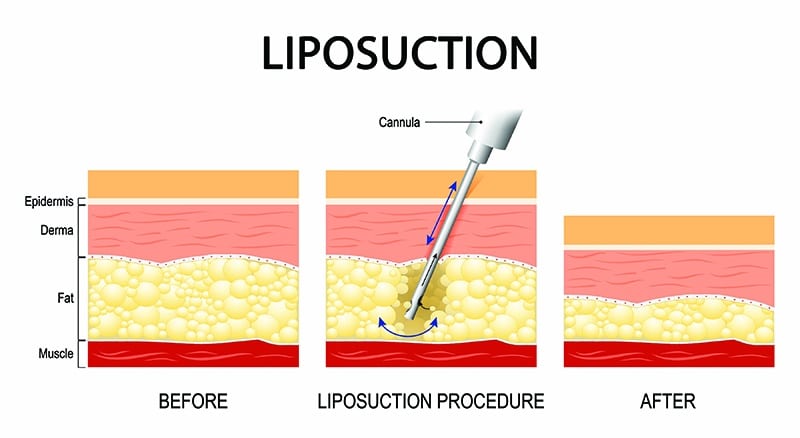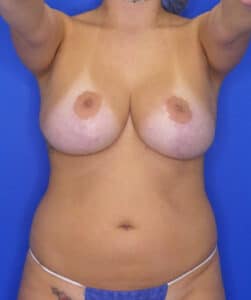Liposuction surgery is a versatile procedure. Lipo, as it is often referred to as, can be performed practically anywhere on the body from large body parts to small including the chin, upper arms, chest, back, abdomen, waist, buttocks, hips, thighs, inner knee, calves and more. A tiny incision is made in the treatment area and a thin cannula is inserted into the incision. The cannula breaks up the fat deposits underneath the skin using a technique of controlled back and forth motion. Then, the excess fat is suctioned out of the body via a surgical vacuum pump attached to the cannula. It’s important to note that fluid retention and swelling are common experiences following Liposuction Miami procedures, but once that subsides, improved body contour is apparent. After surgery, our patients are encouraged to exercise regularly and keep healthy eating habits to maintain long lasting results. For patients wanting a more sculpted look, High-Def VASERlipo Etching may be a better option.
Liposuction Surgery in Miami
Our Stunning Liposuction Results
View Gallery360 Lipo
Liposuction can be performed on various parts of the body during your surgery. At Elite Plastic Surgery, 360 Lipo is one of our most popular procedures since it treats several key trouble areas at once: the upper and lower abdomen, upper and lower back, and flanks. 360 Lipo is a main component of the Brazilian Butt Lift surgery. In addition, it can be combined with other cosmetic procedures including the tummy tuck and breast reduction, among others.
It is important to understand that Liposuction Miami procedures should not be used as a substitute for diet and/or exercise, or as a treatment for obesity, sagging skin, or cellulite.

TYPES OF LIPOSUCTION PROCEDURES
Power Assisted Liposuction
PAL extracts fat via smaller incisions with a mechanical cannula, requiring less manual effort especially in fibrous body parts. Risks and complications are less than with manual lipo since this method is quicker to perform. PAL also tends to leave less bruising and has a shorter recovery time because it doesn’t employ much force to release the excess fat in patients. And, there are no accidental burns, as the procedure uses no heat. MicroAire’s PAL® LipoSculptor™ is a US patented instrument that surgeons use to perform PAL. Its trademark technique does not require as much physical effort as traditional lipoplasty, using reciprocating motion rather than rotating motion once the cannula is inside the tissue. This allows for a better experience for doctors as well as patients. Since the PAL® LipoSculptor does not require heat, as with ultrasonic and laser devices, there are no accidental burns.
Suction Assisted Liposuction
SAL, or traditional Liposuction, employs a pressure vacuum attached to a small cannula, which is manually operated by the plastic surgeon to suction the excess fat as it is broken up.
Ultrasonic Assisted Liposuction
UAL uses ultrasound to disrupt the fat cells, making the removal of fat easier, reducing the chances of bleeding complications, trauma and bruising. The liquefied fat can be drained as its being liquefied or afterwards. This technique is seen as less traumatic and more efficient than other methods, and gives the doctor more control when contouring the body, producing softer, smoother results and better definition. It also produces more skin tightening during the post-operative period. This plastic surgery can be performed on both men and women, in the male breast area, abdomen and back.
Laser Liposuction
Laser Liposuction such Smart Lipo or Slim Lipo uses a laser beam to disrupt the fatty tissue to prevent fat cells from storing more fat. The procedure helps remove localized fat in the chest, male breasts, abdomen, back, hips, thighs and knees. It is minimally invasive, which allows for a quick recovery and results in less bruising, inflammation and bleeding when compared to the traditional procedure.
Benefits of Liposuction
There are both mental and physical benefits from Liposuction. It is considered a very effective and safe method of removal of excess body fat, especially from trouble areas that don’t respond to non-invasive treatments or exercise. Liposuction benefits include:
- Safe method for fat removal
- Removes fat cells permanently
- Removes fat that diet and exercise can’t
- Can be performed on most areas of the body
- Improves your appearance
- Boosts your self esteem
“I recently had liposuction and BBL with Dr. Salama and I give him and his team a very confident 5 star. Dr. Salama has a serious and qualified team and their only goal and focus is on the patient and their satisfaction.”
Liposuction After Ozempic & GLP-1 Weight Loss to Refine Your Results
Losing weight with Ozempic, Wegovy, Mounjaro, or other GLP-1 medications is a major achievement, but some areas of stubborn fat may remain despite your efforts. If you’re looking to further sculpt your figure and enhance your body contours, liposuction can help by targeting those resistant fat pockets in the abdomen, arms, thighs, and flanks.
How Liposuction Complements Your Weight Loss
- Targets Stubborn Fat – GLP-1 medications help with overall weight loss, but some areas may still hold onto excess fat. Liposuction removes these resistant fat pockets.
- Enhances Body Proportions – After major weight loss, your body may not always look as balanced as you’d like. Liposuction creates smoother curves and definition.
- Boosts Skin Tightening Procedures – If you’ve lost significant weight and have loose skin, liposuction combined with a tummy tuck or skin tightening treatments can give you a firmer, more toned look.
- Long-Lasting Results – Once fat cells are removed, they’re gone for good! Maintaining a healthy lifestyle will help preserve your new shape.
RECOVERY FOR LIPOSUCTION
The Liposuction Miami recovery period ranges from a few days to several weeks. The initial stages can be especially uncomfortable due to possible swelling, numbness, burning and soreness, which makes taking care of the treated areas very important. To expedite recovery, reduce swelling and help shape the body, the doctor may recommend compression garments or wraps for several weeks or months after surgery. One to two days after surgery, the doctor will replace the bandages. Five to ten days after surgery, any sutures and drains will be removed. Eight to ten days after surgery, any stitches that did not dissolve will be removed. Compression garments may be removed a few weeks or months later. Doctors may prescribe antibiotics to avoid infection at the incision sites. Final results are visible once the swelling subsides.
RISKS OF LIPOSUCTION
Suction Assisted Liposuction (SAL) risks include numbness, swelling and color changes in the treated area as well as irritation at the cannula insertion point. Fluid imbalance is another complication that may arise after the procedure. In some cases, persistent swelling may last for weeks or months after the procedure. Another risk is an embolism, detached fat that travels to the brain or lungs, or is trapped in blood vessels.
Minimal risks are associated with Power Assisted Liposuction (PAL) including uneven, wrinkled, and/or loose skin that can tighten over time. In addition, there may be moderate changes in the pigmentation of treated area.
While uncommon, the continuous ultrasound energy of Ultrasonic Assisted Liposuction (UAL) may cause the patient’s skin to burn.
As with UAL, Laser Liposuction can cause burning since it uses thermal energy. There are risks of blistering, infection and scarring as well. Skin irregularities, such as dimpling and wavy skin texture, and light or dark skin discoloration may also occur. The discoloration should fade with time, but may require additional treatment.
Ideal patients for Liposuction are healthy, smoke-free individuals, who have no serious medical conditions or life-threatening illness that may prevent the healing process. They also have a positive outlook on life. In order to be good candidates, patients must suffer from excess fat deposits and have a realistic vision for their body contouring.
HOW MUCH DOES LIPOSUCTION COST?
While the cost of Liposuction may be an important factor, the quality should remain more important. Be careful not to let cheap lipo prices supersede good surgery. Our cost for Liposuction surgery includes surgical fees, operating room costs and anesthesia fees. Non-surgical fees include pre-operative exams, post operative garments and treatments like massages.
In addition to non-surgical fees, other variables that affect cost include:
- time and effort required by the surgeon
- the size of the patient
- number of areas being treated
- the experience of the surgeon
- geographic location
The national average cost of Liposuction ranges from $2,000 to $8,000. At Elite plastic surgery, lipo prices begin at $3,000 and financing options are available. When combined with other surgical procedures, it can result in a lower total cost for surgery.
Schedule Your Consult
Ready to achieve your ideal body? Contact us to schedule your consultation. Explore our liposuction gallery to see the stunning transformations our patients have achieved.
For more information about our services, visit Elite Plastic Surgery and discover how we can help you achieve your aesthetic goals.
Schedule A Consultation Today
Loyalty Rewards Program

Join Now!
Earn up to $750 in Points for Every Referral
Earn points for referral and loyalty status to use towards exclusive discounts. Give your friends $100 in points when they sign up.
Earn 250 points at Signup
- Download the ReMembership app here: https://remembership.co/
- Invitation Code: EPS12
Frequently Asked Questions
Q
Before getting any type of Liposuction surgery, your weight should be ideally 20lbs heavier than your ideal or desired weight. In addition to being close to your ideal weight, you should want to address pockets of stubborn, excess fat that are resistant to diet and exercise. Liposuction is not designed to be a form of weight loss, although it can help you to reach your goals. Your plastic surgeon can address any concerns you may have and suggest the best course of action based on your needs and goals.
Q
Having liposuction surgery before pregnancy will not affect your pregnancy. However, results will be affected by the weight gained during pregnancy. If you’re not going to enjoy the results of your liposuction procedure because you have plans for pregnancy soon, you may want to consider having the surgery after giving birth.
Q
Most frequently, women have liposuction done on the abdomen, flanks, back, hips, arms, chin and thighs. Men typically treat their chin, chest, abdomen, back and flanks. Technically, almost any area of the body can be addressed with liposuction, so if your concerns affect different regions of the body than those listed here, you should discuss your options with your plastic surgeon to develop a customized treatment plan that best achieves your desired outcome.
Q
A tummy tuck differs from abdominal liposuction in that it involves the removal of skin and fat of the lower abdomen. It also accomplishes tightening of the abdominal muscles. Liposuction does not remove skin or help with tightening of the abdominal muscles. It’s not unusual for patients to have liposuction along with a tummy tuck, and this combination procedure is a popular choice for individuals who have lost a significant amount of weight or who have trouble restoring their pre-pregnancy figure after giving birth. If you have excess skin and fat, a tummy tuck may be a better choice for you. If you do not have excess skin and have good skin quality with pockets of unwanted fat, liposuction often can provide the desired body contouring.
Q
No, liposuction surgery should not be used as a cure for obesity. Even as a last resort, it is not recommended for people unable to lose weight through diet and exercise.
Q
Cellulite lies under the skin’s surface. Since liposuction removes fat deposits in deeper skin layers, it may reduce cellulite, but will not eliminate it.
Q
Your plastic surgeon will recommend the best method of liposuction for you based on your unique physical factors, taking into consideration the areas of the body to be treated and any additional surgical procedures being done.
Q
For fat transfer, the fat removed in liposuction surgery is harvested and purified so it can be grafted successfully to another area of the body that is being augmented or enhanced, such as the buttocks for a Brazilian Butt Lift. By using a patient’s own natural tissue, the risk of an allergic reaction is virtually eliminated, and it’s often possible to achieve a more natural-looking aesthetic enhancement than with synthetic substances.
Q
Assuming your muscle tone is normal, liposuction can be used to further redefine your muscles. Specifically, Vaserlipo etching, which uses Ultrasonic Assisted Liposuction (UAL), can be used to treat stubborn fat and to provide high definition to the treated areas. In the appropriate patient, this technique can define and sculpt the musculature anywhere in the body.
Q
Massage treatments are vital in achieving optimal results and should commence as soon as possible, typically a day or two following liposuction surgery.
Q
Like any other surgical procedure, liposuction involves risks, but major complications are a rare occurrence. The most commonly seen issues are asymmetries or minor irregularities. During your consult, your plastic surgeon should discuss the complications with you. Be sure that you select a surgeon that prioritizes patient safety and results.
Q
Following liposuction surgery, patients are encouraged to pursue a healthy lifestyle to help maintain their weight. If you do gain weight, the benefits of the treatment may be affected. Once a fat cell is removed from the body it cannot spontaneously regenerate. However, fat cells can grow larger. If you gain weight, fat cells may become larger and move into the treated area--or they may not. Typically, the weight gain my be distributed to the areas without liposuction. However, results can be unpredictable. That said, any changes in body contouring can be addressed with additional treatment if desired.
Q
The process of Lipo 360 is no different from regular Liposuction. Lipo 360 just refers to a specific group of areas where the Liposuction is done: the upper and lower abdomen, the flanks, and the upper and lower back.
Q
While there are several different Liposuction techniques nowadays, it’s really a matter of preference. Dr. Moises Salama employs Power Assisted Liposuction (PAL) for all Liposuction surgeries. He also uses Vaser lipo, or Ultrasonic Assisted Liposuction (UAL), to get high definition results. His extensive training helps him determine the best method for your needs and goals, rather than using a “one-size-fits-all” approach for all patients.





